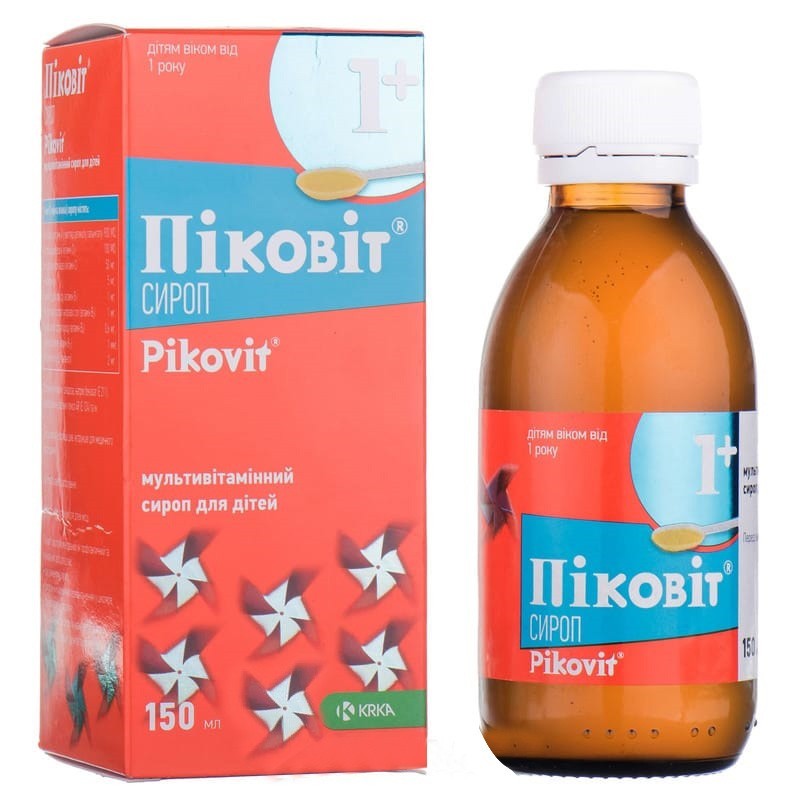



 Secure and encrypted payment processing
Secure and encrypted payment processing We ship to over 40 countries including the USA, UK, Europe, Australia and Japan
We ship to over 40 countries including the USA, UK, Europe, Australia and Japan Guaranteed refund or reship if you haven't received your order
Guaranteed refund or reship if you haven't received your orderPicovit syrup contains 9 important vitamins that are involved in the regulation of many biochemical processes in the body. the effects of vitamins and minerals in the body are mainly physiological, not pharmacodynamic. they play an important role in maintaining vital functions and psychological health.
Vitamins of group B (B1, AT2, AT6, pantothenic acid and nicotinamide) take part in the metabolism of carbohydrates, proteins and fats, and also play an important role in the functioning of the nervous system. Vitamin A is necessary for the development of epithelial cells and for the synthesis of visual pigment. Vitamin D regulates the absorption of calcium and promotes proper mineralization of bones and teeth. Vitamin C controls the absorption of iron and is involved in many redox processes in the body.
There is no data on the pharmacokinetics of the drug Picovit syrup. Water-soluble vitamins (group B vitamins, vitamin C and biotin) are well absorbed in amounts that correspond to daily needs. Excess quantities are excreted in the urine, in some cases with feces. These vitamins are in the body in limited quantities, so they should be taken regularly to maintain appropriate concentrations in the tissues.
In the presence of fats when taken orally, fat-soluble vitamins A and D are well absorbed in the small intestine.
The use of syrup Picovit is mainly intended for children:
For the prevention of hypovitaminosis for children aged 1-3 years - 1/2 scoop (2.5 ml) of syrup per day; 4-6 years - 1 scoop (5 ml) of syrup per day; 7-14 years - 1.5 scoops (7.5 ml) of syrup per day.
For the treatment of hypovitaminosis in children aged 1-3 years - 1 scoop (5 ml) of syrup 2 times a day; 4-6 years - 1 scoop (5 ml) of syrup 3 times a day; 7-14 years - 1 scoop (5 ml) of syrup 3, maximum 4 times a day.
Syrup should be given to the child after eating using a measuring spoon, or added to tea or fruit puree.
With reduced appetite, syrup should be taken for 1 month, with other indications, if necessary, depending on the duration and frequency of symptoms after consulting a doctor.
When using the drug in recommended doses, side effects do not occur.
On the part of the immune system: hypersensitivity reactions to the components of the drug are possible, including anaphylactic shock, bronchospasm, Quinckes edema.
From the side of metabolism and digestion: hypercalcemia.
From the nervous system: headache, dizziness, drowsiness.
From the side of the organ of vision: visual impairment.
From the digestive tract: dyspepsia, nausea, vomiting, belching, pain in the stomach, constipation, diarrhea, increased secretion of gastric juice.
On the part of the skin and subcutaneous tissue: rash, urticaria, itching, redness.
From the kidneys and urinary tract: discoloration of urine, hypercalciuria.
General disorders and violations of the conditions of admission: hyperthermia, irritability, hyperhidrosis.
During prolonged use in high doses, the following adverse reactions may occur.
Metabolic and digestive disorders: hyperuricemia; impaired glucose tolerance, hyperglycemia.
From the nervous system: paresthesia.
From the side of the heart: arrhythmia.
From the digestive tract: gastrointestinal disturbances.
On the part of the skin and subcutaneous tissue: hair loss, seborrhea.
From the kidneys and urinary tract: renal failure.
Laboratory indicators: transient increase in AcAT, alkaline phosphatase, lactate dehydrogenase.
If any adverse reactions occur, the drug should be discontinued.
Before taking other vitamin, mineral and / or mineral and vitamin preparations at the same time, you should always consult your doctor.
Picovit syrup is not recommended for patients with diabetes, since 5 ml of syrup (1 scoop) contain 3 g of sugar.
It is prescribed with caution to patients with liver disease, acute nephritis, cardiac decompensation, gallstone disease, chronic pancreatitis, allergic diseases, idiosyncrasy, and neoplasms.
Pregnancy should not be planned earlier than 6-12 months after high-dose retinol therapy (10,000 IU), due to the risk of embryonic disturbances due to the high content of vitamin A in the body. Urine may stain yellow due to the content of vitamin A. This effect is safe.
Special information on some excipients. Picovit contains sucrose, glucose and azo dye E124. Patients with rare hereditary forms of fructose intolerance, glucose-galactose malabsorption, or sucrose-isomaltase deficiency should not take this drug. E124 azo dye may cause the development of allergic reactions.
During pregnancy and lactation, you can take vitamins and minerals after a mandatory consultation with a doctor. The doses of vitamins in the drug Picovit syrup are adapted for children.
Children. The drug is used in children over the age of 1 year.
There are no reports regarding the ability of the drug to affect the reaction rate when driving vehicles and working with other mechanisms.
Due to the risk of developing hypervitaminosis a, the simultaneous use of the drug Picovit with other drugs containing vitamin A, or with oral retinoids, is not recommended. when treating with sulfonamides, the use of vitamin C in high doses should be avoided to prevent the development of crystalluria. pyridoxine reduces the effectiveness of levodopa if the patient takes only levodopa. riboflavin inhibits absorption and reduces the effectiveness of antibiotics. therefore, it should be taken at least 3 hours before taking the antibiotic.
When taken in recommended doses, intoxication is unlikely. prolonged use of picovitis in high doses can lead to the development of hypervitaminosis a and d, although the likelihood of an overdose of syrup is negligible. with an overdose, the treatment is symptomatic.
In the original packaging for protection against light at a temperature of no higher than 25 ° C. after opening the vial, use the syrup for 2 months.